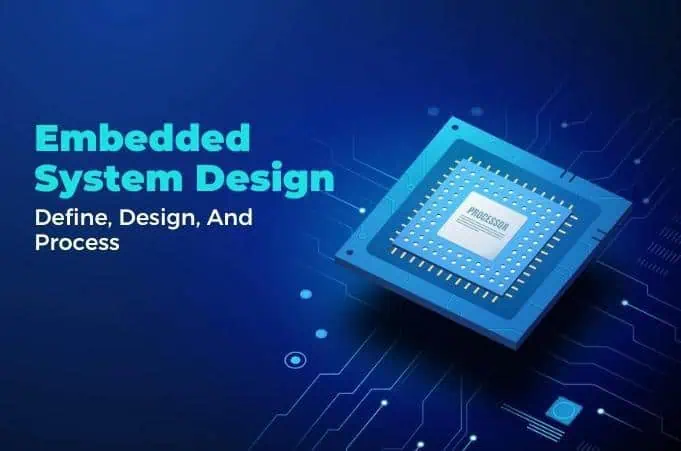
An Embedded Electronics Design is part of a device that uses electronic hardware and mechanical parts. These systems control the physical operations of the machine. Earlier, embedded systems development was based on microprocessors, and now they are based on microcontrollers (i.e., microprocessors with integrated memory and peripheral interfaces).
Embedded systems range from low complexity with a single microcontroller chip to high complexity with multiple chips. The systems are dedicated to specific tasks, and thus, they require proper optimization and an increase in reliability and performance. Specifically speaking about embedded system design, the complexities are not confined to chips, but also extend to the design of hardware and software components.
In this article, we shall walk through the basics of embedded system design and also its applications.
Embedded systems
An embedded system is a computer system that consists of a combination of a processor, memory, and input/output peripherals. The total system generates the desired output in a mechanical or electronic system. There are billions of embedded systems devices like automobiles, digital devices, electronic appliances like washing machines, microwaves, and other devices like telephones, etc.
All these devices have memory, a processor, peripherals, sensors, imaging systems, etc. Thus, the embedded system design is much more sophisticated and designed for specific use. Here, the input and output are specific. In some systems, where the real-time desired output is to be generated, real-time embedded systems are curated, which are intricate.
Embedded system design
As discussed, an embedded system = hardware + software.
Hardware → to perform the task
Software → to process the task
Both hardware and software are interlinked to generate the desired output. The processor is the core part of the entire system. Depending on the needs, several interfaces and peripherals are interconnected to the system.
The systematic architecture of an embedded system can be depicted below.
- Processor
It is the heart of an embedded system that takes an input and produces an output after processing data. It consists of two units:
- Control Unit (CU) – It fetches instructions from the memory.
- Execution Unit (EU) – It has circuits that implement instructions for data transfer and conversion instructions.
A processor runs these units over and over as the instructions are fetched from memory.
There are different types of processors-
- General Purpose Processors (GPP) like Microprocessors, Microcontrollers, Embedded Processors, Digital Signal Processors, and Media Processors
- Application Specific System Processors (ASSP)
- Application Specific Instruction Processors (ASIPs)
- GPP core(s) or ASIP core(s) on either an Application Specific Integrated Circuit (ASIC) or a Very Large Scale Integration (VLSI) circuit.
The choice of a process depends on the desired output and the complexity of the application.
- Interfaces
Every physical device uses an interface to connect with the outside world. It selects two important boundaries:
- Between CPU software and digital interface logic.
- Between digital and analog sides of the interface.
This communication is established with peripherals and other microcontrollers as a part of the whole embedded world.
There are many interfaces like-
- Serial communication interfaces
- Synchronous serial communication interface
- USB
- Networks like WiFi
- Debugging like JTAG
- Field buses like CAN
The choice of interfaces differ based on the desired output.
- Peripherals
The different peripheral devices establish communication between the embedded system and the outside environment in combination with the microcontroller. The choice of peripherals depends on:
- Operational speed of the microcontroller
- Space and prototyping of end-product
- Memory storage for data and programs
- A number of input and output devices connected
- Power consumption for maintaining the efficiency of the embedded system
There are various interfaces like-
- Displays, e.g: Graphic LCD
- Multimedia cards, e.g: SD Cards
- Timers, Counters
- Analog to Digital Converters
- Input devices, e.g: keypad
- Output devices, e.g: LED
- Serial Communication Interface
- Firmware
The flash memory chip in an embedded device is where the special software that controls the device’s functions is stored. It acts as a-
- Bridge between hardware and software applications.
- Channel of communication between human and machine
The services associated with firmware are-
- System Architecture
- Design and Development
- RTOS/ OS/ Bare Metal Applications
- Porting & Optimization
- System Integration & Security
It enables direct control of circuits and hardware components that include the above services to make execution seamless.
- Embedded Software
This software is embedded inside the system that runs on top of firmware to provide unique features. They control different parts of the mechanical system. Embedded software is-
- Easy to configure and updatable.
- Are customizable and functionalities can be increased.
There are different types of embedded software like-
- Embedded bare-metal software
- Embedded Linux software
- Embedded RTOS software
- Embedded networking software
Some applications do need real-time data processing, which gives rise to real-time embedded systems, which are prominently used in today’s systems.
Designing Embedded Systems
All the parts mentioned above are integrated together in the following steps.
- Defining system specifications
- Defining system hardware and software requirements
- Selecting mainframe and associated technologies
- Defining the resources required and analyzing the budget
- Selecting hardware and software components
- Designing hardware, i.e., schematics, layout, PCB, and board
- Developing firmware and testing
- Entire system integration and testing
Summing Up
Embedded system design is an interesting field that integrates various skills and tasks. The advanced embedded system serves its applications in medical and industrial equipment, transportation systems, military equipment, consumer devices, and much more.
Technosoft Engineering helps companies make smart and connected products by working with them on advanced embedded systems, embedded solutions, home automation, metering, sensor technology, home appliances, and medical devices. From consultation to designing custom PCB and embedded systems, the services cover 360-degrees embedded, connectivity, applications, mobility, and cloud solutions.
If you too want to develop an outstanding technology with greater applicability in any field, you can connect with us!

